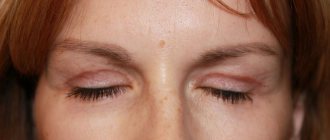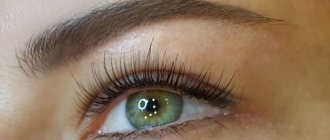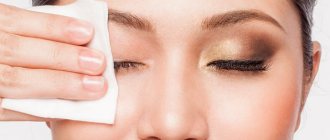Swelling after blepharoplasty is a natural side effect that is typical for any surgical procedure. The procedure itself is aimed at solving aesthetic problems in the periorbital zone (congenital and acquired).
During the process, the surgeon makes one or more incisions with a scalpel, removes excess skin and fatty tissue, and finally applies sutures. During the rehabilitation period, swelling occurs, often accompanied by the appearance of bruises. This phenomenon lasts 7-10 days, but due to individual characteristics or due to incorrect work carried out by a specialist, it may not go away much longer.
Causes
Skin tightening involves breaking the integrity of the dermis and soft tissues underneath, resulting in damage to the vascular network, resulting in swelling and bruising.
They can appear even after endoscopic surgery - several punctures are enough to develop a side effect.
The correction area is particularly sensitive and has a congestion of blood vessels - they are damaged during the operation.
Compression of the venous tissue and capillaries occurs, as a result of which the outflow of lymph is disrupted. Also, the walls of blood vessels become more permeable; fluid from them actively exits into the intercellular space and accumulates in it.
With transconjunctival blepharoplasty, the side effect is less noticeable. This is due to the method of performing the operation - an incision is made on the inside of the eyelid (on the mucous membrane).
This method is considered less traumatic, however, this procedure has a number of limitations and is indicated if it is necessary to correct a moderate problem.
How to reduce the consequences
To minimize the problem, it is necessary to follow all the doctor’s prescriptions and recommendations before the procedure.
- Avoid alcohol. Drinking alcoholic beverages provokes dehydration of the body, as a result of which a person begins to feel thirsty and drink large amounts of water.
- Eliminate salt from your daily diet - it stops the removal of fluid by binding water molecules together.
But even in this case, it will not be possible to completely avoid swelling.
What should I do if the swelling or bruising lasts longer?
If traces after surgery persist longer, you can consult a doctor so that he can prescribe additional medications and cosmetics that will make it easier to eliminate the consequences of the operation.
However, it is important to remember that in the first days after blepharoplasty, swelling may increase slightly (this is a completely physiological process), but then it steadily decreases. The same goes for bruises. The blood that gets under the skin during the operation may be slightly redistributed; during the process of coagulation and resorption, the bruise can change not only its color, but also become a little wider. If this happens in the first days after plastic surgery, do not be alarmed.
By following the recommendations given and all the doctor’s advice, you can effectively speed up the process of disappearance of bruises and swelling.
Cost of eyelid surgery
Formation zone
On the lower eyelids
After blepharoplasty of the lower eyelids, swelling lasts, on average, about a week.
It is almost impossible to avoid the phenomenon due to the sensitivity of the skin around the eyes and the peculiarities of the anatomical structure of this area. In some cases, especially with the classical correction method, swelling may spread to a larger perimeter, reaching up to the cheekbone.
On the upper eyelids
The symptoms are less severe, but the rehabilitation period increases.
This is due to the fact that the connective tissue of the upper eyelid is not as actively supplied with blood than the lower eyelid. In some cases, eye asymmetry may occur. There may be several reasons.
- Varying degrees of surgeon intervention due to different initial characteristics of the eyelids. If it was necessary to remove a larger number of subcutaneous hernias in one eye, then the severity of the edema will be more noticeable.
- Low tone of the eye muscles and non-simultaneous healing of the suture.
Natural consequences of upper and lower eyelid surgery
Since plastic surgery is considered an operation that takes place under local anesthesia, the following conditions may occur:
- moderate swelling;
- increased skin sensitivity;
- small bruises under the lower eyelids;
- feeling of heaviness of eyelids;
- increased tearing or dry eyes;
- fear of light;
- double vision;
- blurry vision.
There is no need to panic: such consequences are considered natural and disappear within 2 weeks. The occurrence of all symptoms is extremely rare. Most often, one or two symptoms from the listed list appear. Basically, this is swelling and double vision, which can remain for a long time. But with a competent approach to skin care, you can reduce the rehabilitation time.
How long does swelling last?
The swelling goes away in about 2 weeks.
In some cases, recovery may take much longer. This is due both to the individual characteristics of the client and to contraindications not identified during preparation. Among them are problems with the urinary and cardiovascular systems.
The length of the rehabilitation period depends on several factors.
- Type of surgery . In the case of classical exposure and a sufficiently large volume of work, swelling, accordingly, can last more than 14-16 days. Transconjunctival plastic surgery or sutureless technique is characterized by a low degree of swelling due to less trauma during surgery.
- Age . As the skin ages, regenerative processes in connective tissue cells also slow down. In young people, recovery is much faster.
- Individual characteristics . If the patient's skin is highly dense, then the swelling will last much longer. When the vessels are close to the surface of the dermis, swelling and bruising occur.
- Skin type . A more sensitive and thin structure is characterized by a rapid recovery period due to a dense network of blood vessels. However, in this case, swelling is always accompanied by hematomas formed during internal hemorrhage.
- Pronounced subcutaneous tissue . The tumor lasts a long time and differs in the intensity of its manifestation (since the subcutaneous tissue is abundantly supplied with blood).
A systematic change in the degree of swelling is also considered normal. So, in the morning it can be stronger than in the evening. This is due to the fact that during sleep a person is in a horizontal position, as a result of which the process of lymph outflow is inhibited. This is why many experts recommend resting on a high pillow at night.
The degree of swelling by day with the recommendations of plastic surgeons
| Day | Progress and expert advice |
| 1 | The first manifestation of swelling. It can be observed both immediately after the operation and after some time. The necessary procedures are performed by a nurse in the hospital. At home, you need to reduce physical activity as much as possible, use prescribed medications and apply cold compresses. |
| 2 | The swelling appears gradually. It reaches its peak in the late afternoon. At this time, antiseptic patches or a sterile bandage are placed on the eyes of the operated person in the suture area. Additionally, a bruise appears that can reach the cheekbones. |
| 3-4 | The level of fluid in the intercellular space decreases. It is recommended to try to blink as little as possible. It is permissible to take a not too hot bath so that water and shampoo do not come into contact with the eye area. |
| 5-7 | By the end of the week, the severity visually decreases. If non-absorbable material is applied, the sutures are removed. The antiseptic patch is removed. |
| 10 | Symptoms practically disappear, only barely noticeable swelling remains. It is allowed to use contact lenses and watch TV, as well as moderate computer work. |
| 14-20 | Appearance returns to normal. In rare cases, slight asymmetry may be visible. The use of decorative cosmetics is allowed after the second week of the rehabilitation period (preference should be given to products for sensitive skin). |
| 20-60 | The symptom goes away completely. It is possible to resume your normal lifestyle. The surgeon may prescribe physical procedures. |
How should recovery proceed?
The technology for performing eyelid blepharoplasty has long been well established, so the procedure rarely causes serious adverse reactions and complications.
Despite this, it is necessary to pay special attention to the first days after surgery. The quality and speed of rehabilitation depends on them
The following factors may affect the length of the recovery period:
- patient's age;
- technique and scope of blepharoplasty;
- the thickness of the subcutaneous fat layer (the denser it is, the slower the swelling goes away).
The procedure is performed under local or general anesthesia. If the intervention was minimally invasive (transconjunctival or laser correction), the woman goes home the same day, preferably with an accompanying person. With classic blepharoplasty, the patient remains under medical supervision until the next morning or longer.
Scarring of the postoperative wound continues for 10–30 days. New connective tissue appears at the site of the incision and after 1.5–2 months only a barely noticeable scar remains.
The first days after blepharoplasty
No matter how well blepharoplasty is performed, it is always accompanied by early side effects. These include bruising, swelling, problems with the incision, and an unattractive appearance.
Seams
Sutures after blepharoplasty are applied only in the case of classical intervention. With transconjunctival access, when the incision is made from the inside of the mucosa, a bandage and mesh bandage are used.
If blepharoplasty was performed through a skin fold and the suture is torn, the wound is re-sutured and an antiseptic sticker is applied. The cause of the complication is incorrect alignment of the wound edges during surgery, severe swelling, mechanical damage, or early removal of surgical sutures.
Edema
Swelling is considered a completely normal reaction of the body to injury, so it does not cause concern on the first day. If tissue swelling lasts more than a week, this is a complication that needs to be treated.
Avoiding spicy, salty and too hot foods and applying cold to the eye area will help reduce the intensity of swelling.
Scarring
As you know, scar tissue is a fickle thing. It is very difficult to predict or prevent its occurrence. Rough scars, granulomas and cysts form due to an individual predisposition to the formation of keloids or improper suturing of the incision.
Small fibrous seals resolve on their own over time, the rest have to be treated or polished.
Bruises
Hematomas may appear immediately after blepharoplasty or several days later. Many women consider them the most unpleasant complication - indeed, with such “decoration” it is difficult to go to work or to the store.
How long do bruises last? Usually the resorption period lasts up to 3 weeks. With a longer process, the bruises thicken and form persistent infiltrates, which are difficult and take a long time to resolve.
The safest and easiest to treat is subcutaneous hematoma. Despite its frightening appearance, it is easily eliminated with local remedies. Tension and retrobulbar hemorrhages require more active therapy.
Bags under the eyes
One of the goals of blepharoplasty is to remove excess skin and hernias under the eyes. If the surgeon did not try hard enough and did not completely remove the fat layer, sagging skin will still be noticeable, and swelling will make it more pronounced.
How to remove a side effect
For every patient who has undergone a blepharoplasty procedure, the question of how to minimize swelling is relevant.
After discharge from the hospital, the doctor will give recommendations that should be strictly followed in order to avoid complications and speed up the rehabilitation period.
Medicinal ointments
- Lyoton . Activates the restoration processes of skin receptors, increases the level of vascular resistance by reducing the permeability of the walls. Additionally, they have an anti-inflammatory and analgesic effect, and also prevent the occurrence of blood clots.
- Retinoic ointment . The effectiveness is due to the retinol included in the component composition, which helps tighten and heal the skin.
- Blefarogel . The product relieves swelling and accelerates the recovery of small wounds. Additionally, it has a moisturizing effect. Contains glycerin, aloe juice and hyaluronic acid.
- Heparin ointment . In addition to swelling, it helps to remove dark circles in the periorbital area.
- Troxevasin . Fights puffiness by limiting moisture intake. Moreover, it promotes its natural resorption.
- Afulim . It has a tonic effect on the walls of blood vessels, thereby improving blood circulation.
- Traumeel . Despite the fact that this homeopathic drug is intended for the treatment of the musculoskeletal system, it is actively used to relieve edema. This is due to the high content of herbal decoctions in the component composition.
- Ointment with Chinese mushroom extract . It has a calming effect on the nervous system and helps increase blood flow. Pain relief.
Exercises
Special gymnastics is necessary for the rehabilitation period. Through systematic repetitions, the tone of the muscle tissue is normalized and excess fluid is removed.
Exercises, despite the recommended frequency, do not cause discomfort or fatigue.
You should first warm up the muscles - to do this you need to look away in different directions several times to the limit. The eyebrows should remain motionless.
- Tilt your head back and blink frequently for 40 seconds, looking up.
- Open and close your eyelids wide several times.
- Place your fingers on your eyelids and try to open your eyes. These manipulations should be done carefully, without much pressure.
- You need to tilt your head back again and focus your gaze on the tip of your nose for 10 seconds.
- Press the skin in the temporal region with your fingers and gently pull it to the side.
Grinding
It is not necessary to undergo laser resurfacing after blepharoplasty.
However, many patients may be prescribed to achieve optimal results. Efficiency lies in the targeted effect on certain layers of connective tissue at different depths using a laser, which causes virtually no damage to the surface of the dermis.
During the procedure, only hemoglobin, melatonin and water located in the cells are affected.
The following types of laser are used:
- erbium;
- carbon dioxide.
Skin care
For the proper course of the rehabilitation period and the removal of swelling in the eye area, you should adhere to special care of the periorbital zone.
On the first day after blepharoplasty, it is forbidden to wash your face with running water.
Eyelid care during recovery is as follows:
- washing twice a day (after the first day) in the morning and evening;
- low intensity massage on the affected area;
- application of an antiseptic drug;
- after 7 days it is possible to use additional cosmetic products;
- after 2-3 weeks it is allowed to use gentle scrubs.
Cold compresses have an important effect on swollen eyelids: ice is a fairly strong anti-inflammatory agent.
However, it should be used so that the dermis is not subjected to sudden changes in temperature. The best option is to place it in a cloth and then wrap it in polyethylene. The skin should not be heated before this.
Compresses are applied in the area of the cheekbone and on the eyelid area for about 20 minutes with a minimum interval of half an hour. These activities are carried out only during the daytime.
Physiotherapy
Severe swelling can also be relieved through physiotherapy - under the influence of microcurrents the swelling subsides. The result is achieved by stimulating the outflow of lymph and removing water from the intercellular space.
Massage
Massage movements should be carried out delicately, only lightly touching the skin around the eyes to avoid irritation of the integument. There are several methods of influence:
- in the area of the inner corner of the eye;
- in the temporal region;
- parallel to the eyelash line, along the lower eyelid to the center of the eye;
- along the edge of the upper eyelid in the direction of the temporal bone.
An unpleasant consequence of blapharoplasty is swelling of the eyelids and eyes. Causes, types, methods of treatment
When there is excess skin in the eye area, today we offer plastic surgery – eyelid blepharoplasty.
The procedure is quite simple, but some complications may arise during the rehabilitation period. By following the recommendations of doctors, you can quickly get rid of them. We'll tell you when to expect the swelling to subside and what actions you can take to speed up this process.
Folk remedies
To relieve swelling from the operated area, you can also resort to traditional medicine, but you should first seek advice from a specialist.
Tumors go away well after compresses based on components such as oak bark, sage, linden or chamomile. Parsley juice also helps get rid of the problem quite well.
It is recommended to prepare a decoction from only one ingredient.
To prepare, you need to add 1 tablespoon of crushed raw materials to 0.5 liters of boiling water and let it brew.
After cooling, soak a cotton pad in the resulting liquid, squeeze it out and apply it to the local area for about a quarter of an hour.
Late risks with photos
Read the description and photos of possible negative consequences of the operation, which include the formation of bumps, scars, scars, as well as different or round eyes, hernias and other side effects.
Seals, bumps, knots, balls
The formation of various compactions, lumps, and nodules can be the result of improper treatment of hematomas. Repeated consultation with a specialist is necessary. This complication is quite common after blepharoplasty.
Blepharoptosis
Blepharoptosis is a sagging of the upper eyelid that occurs as a result of damage to a branch of the nerve during surgery. Restoration of the integrity of the nerve and innervation of the corresponding muscles occurs within 1-2 months after surgery. In some cases, repeated intervention is required.
Lagophthalmos
Lagophthalmos is an ophthalmological pathology in which the normal process of closing the eyelids is disrupted. The cause of the defect is excessive removal of the skin. If the eyes do not close, the normal process of moistening the cornea is disrupted, the result is a decrease in its transparency with subsequent loss of vision. Treatment is repeated surgery.
Why does seams come apart and what to do about it?
The cause of this complication may be a violation of the suturing technique, severe swelling, or infection. The defect is eliminated by repeated suturing; in case of infection, antibiotic therapy is necessary.
Can colloidal scars and scars remain and how to avoid pathology?
Normally, scars resolve within 3-5 months after surgery. In some cases, the formation of rough or keloid scars occurs. The reasons for their occurrence include:
- individual characteristics of the body;
- violation of suturing technique;
- divergence of seams.
Tearing
Why did my eyes start to water and what should I do about it? This unfavorable consequence is due to a change in the localization of the lacrimal openings (their displacement) or a disruption of the normal outflow of tear fluid, which arose during tissue scarring. Treatment is surgical.
Round eye
This complication is characterized by a change in the shape of the palpebral fissure. It manifests itself as dry conjunctiva, excessive lacrimation, and hyperemia. Treatment is repeated surgery.
Cyst
A cyst is a formation limited to a capsule and containing contents. Formed at the tissue cut line. They may disappear on their own after 2-3 months; in some cases, they require opening and removal.
Different eye sizes
It happens that one eye becomes smaller than the other as a result of surgery: is this normal? Changes in the shape and size of the palpebral fissure occur due to excessive tissue removal. The consequences can be various ophthalmological pathologies. Treatment is surgical.
Drooping of the upper eyelid
Drooping eyelid is blepharoptosis. The reasons for its formation, clinical manifestations, and treatment are similar to those for blepharoptosis.
Keratoconjunctivitis: what is it and how to get rid of the problem?
Keratoconjunctivitis is an inflammatory process localized in the conjunctiva and cornea of the eye. Is an individual response to intervention. Treatment - antibacterial agents, agents that normalize the condition of the mucous membrane of the eye.
The feeling of heaviness does not go away
A feeling of heaviness in the eye may be a consequence of the formation of a hematoma or the development of an infectious and inflammatory process. Treatment depends on the cause of this manifestation.
Soreness
Soreness of the eyelids occurs in response to trauma to tissue structures. Treatment consists of prescribing painkillers. If pain persists for a long time, even a month after surgery, a doctor’s consultation is necessary.
Itching
Sometimes patients complain that their eyes itch. This manifestation occurs due to dryness of the mucous membranes of the organ of vision. The reasons may be varied. Treatment depends on the cause of this manifestation.
Dips
The formation of hollows under the eyes is a consequence of excessive removal of fatty hernias of the eyelids. Correction requires lipofilling (injection of adipose tissue into the eyelid area).
Photos before and after
Contraindications
Additionally, a number of restrictions for the rehabilitation period should be taken into account.
- Reduce time spent watching TV, working on the computer and reading.
- Protect your eyes as much as possible from exposure to sunlight and ultraviolet radiation. In the summer, use glasses with darkened lenses.
- It is recommended to sleep on a fairly high pillow, but the head tilt should not be too strong.
- Eliminate salty foods and alcoholic (especially carbonated) drinks from your diet. If possible, give up cigarettes.
- Drink no more than 1.5 liters of water per day.
- It is strictly forbidden to exert mechanical influence on the eyelid area (touching with hands, rubbing).
- You should also not lower your head down. Even when washing your hair, you need to tilt it back.
- For the first couple of weeks, avoid cosmetics.
- Do not play sports or perform other physical activities.
- Do not visit the sauna, bathhouse or solarium. Temperature fluctuations (including sub-zero temperatures) negatively affect the recovery process.
Among the contraindications to blepharoplasty, which provoke a high degree of edema, are:
- fluctuations in blood pressure;
- oncology;
- diabetes;
- pregnancy;
- lactation;
- poor blood clotting;
- liver and kidney pathologies;
- inflammatory processes in the periorbital zone;
- period;
- retinal detachment;
- infectious diseases;
- inflammatory processes in the tear ducts;
- conjunctivitis.
First days after surgery
After performing the operation, the doctor will apply stitches and, to keep them in place, will stick special adhesives on them, which will help the stitches remain in the desired position, even when you actively gesture using facial muscles.
A few hours after the operation, the patient will be allowed to go home, since the operation is easy and does not require constant monitoring after it.
Immediately after the operation and over the next few days, the person will see bruises and smudges on his face, especially in the places where the operation was performed. This is normal, since there was a surgical intervention, it is natural that the tissues need to heal, and only then will they be able to recover and become their usual color and shape.
There will also be traces of cuts, very thin scars, a feeling of heaviness in the eyelid area, dry eyes and a general painful condition. All this lasts approximately 6-10 days after the operation, the skin will tighten, the marks will be almost invisible, especially to people who do not know anything about the fact that some kind of surgical intervention was performed.
It is worth remembering that the figures given here are average; the speed of complete recovery depends only on the ability of the tissue to regenerate and restore, on the age and type of skin.
Bruises will appear on the second day after the operation, this is normal, the skin around the eyes will turn blue, after a few days it will turn yellow, then turn pink and finally return to its natural appearance.
In the first days after surgery it is recommended:
- No smoking.
- Do not drink alcoholic beverages.
- Use special cosmetics for restoration.
- Do not use decorative cosmetics until a week or two after surgery.
- Don't work.
- Have a relaxing time.
- Do not go to baths and saunas to avoid hemorrhage.
- Do not read a lot and do not look at computer, TV, phone, tablet monitors.
- Don't play sports.
- Try to wear glasses, not contacts.
- Wear sunglasses if you spend a lot of time in the sun.
- Apply compresses.
- Wash your hair only a few days after surgery.
- Avoid prolonged exposure to the sun.
- Strictly take medications prescribed by the surgeon.
- It is possible to use eye drops and ointments that will reduce the risk of wound inflammation.
- Take painkillers if needed.
- Eat properly.
The stitches will dissolve in about three days if the surgeons used special threads during the operation, but if the threads were ordinary ones, you will need to return to the hospital, where they will be removed along with the patches supporting them. It will immediately feel easier, the feeling of tight skin will disappear.










